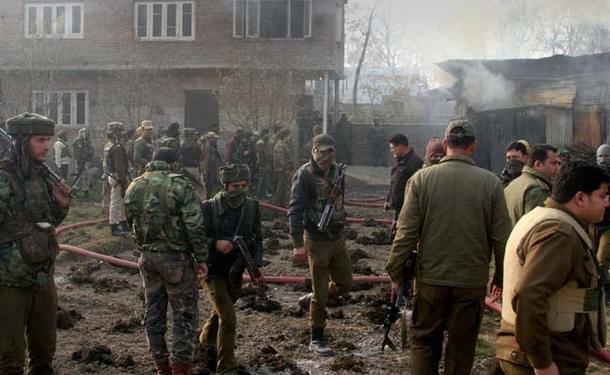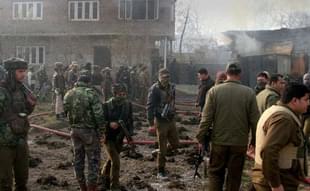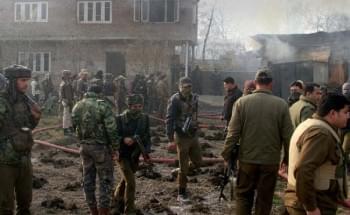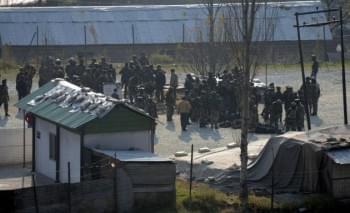Politics
Will Kashmir See A New Wave Of Suicide Terror?
Syed Ata Hasnain
Jul 15, 2016, 05:27 PM | Updated 05:27 PM IST
Save & read from anywhere!
Bookmark stories for easy access on any device or the Swarajya app.


A brief history of suicide terrorism in Kashmir, and why it is safe to be prepared for a new wave.
Since the period 1999-2003, a new generation has grown up all over India. Forgotten is this period of J&K’s militant history to which we can trace today’s elevated sentry posts at important installations, double barrier entry gates and much more barbed wire than what is ever desirable. It was suicide terror which brought about all this.
Today there are just 150 terrorists of marginal capability present in Kashmir and less than 75 in the Jammu region. However, in South Kashmir, a ‘new militancy’ is growing which many say may grow and manifest as ‘new terrorism’. A 21 year old militant leader Burhan Muzaffar Wani, from a reasonably well to do family from Tral/Pulwama has emerged.

Young, energetic and fully radicalized, he is uploading videos calling for a new jihad. It is the talk of the town among younger people in Kashmir and I am getting messages from all over J&K expressing anguish at this development which is finding much attraction among the younger generation. He had even uploaded his photograph along with ten others in well-fitting combat fatigues and the symbol of machismo, the AK-47.
Such movements which have a way of turning nasty. Burhan is spreading the message of radical Islam with a trans-national imprint and its effect is admittedly attracting the attention of the young. Sooner than later, he must demonstrate his arrival; thus far it is only videos and photographs on social media. Terrorists are bereft of empathy with any segment of society and the weakest is usually the target. They have a way of conducting the most bizarre acts against the run of trends and end up showing their flag with high profile acts. Suicide terror is one of them.
If my memory holds right it was July 1999 when the first of the Pakistan sponsored ‘fedayeen’ (hereafter referred as suicide terrorists) struck the BSF DIG Headquarters at Bandipur in North Kashmir. The LeT had been active in J&K since 1992 and executed many criminal terror acts including minority killings but a small squad suicide terror attack had hardly been witnessed before. Most observers would be unaware that the July 1999 was the period in which the Kargil operations were in their last intense phase and North Kashmir was left with few troops; the famous 8 Mountain Division having redeployed to Dras.

A flurry of similar attacks followed at Chak Nutnas (a larger strike against a newly arrived Rashtriya Rifles (RR) unit) near Handwara, Manasbal and Beerwah, where quite a few lives were lost by the RR.
On 03 Nov 1999 a suicide squad carried out a sneak attack on the Badami Bagh entrance at Batwara Gate killing the Defence PRO. This was followed by two suicide car bomb attacks in December 1999 and April 2000 almost at the same spot, again leading to casualties. However, the most daring of these sneak attacks took place on the headquarters (HQ) of the 1 Sector RR at Khanabal, near Anantnag on 13 Jan 2000.
It was meticulously planned. The HQ locations are divided by the National Highway and there were fixed timings at which the gates would open for essential administration between the two parts. The terrorists had observed that 6 PM was one such time when food was transported from the administrative area across to the main HQ.
The terrorists stole a Maruti van at about 4 PM from the vicinity of Anantnag and a general alert was issued by the JK Police. Dressed in combat fatigues four terrorists drove up in the van at about 6.15 PM and halted on the main road between the two gates which were open. They dismounted firing from the hip and even shot rockets at the sentry post of the main HQ gate.
One of the terrorists was killed by the sentry while another probably lost nerve and escaped along the perimeter wall. Two of them ran through the open gate and disappeared into the darkness in the HQ complex. It emerged that they holed up in the first floor of a block of four flats. The Army and Ikhwan did their best to flush them out but ultimately had to resort to the time tested method of blowing up the house to eliminate the two terrorists, not before a few lives had been lost.
We had occasion to speak to one of them as he lay dying under the cornice of one of the buildings. The information gleaned was something which could be applied across the board to most Pakistani terrorists. They came from impoverished background, some were terminal cases of HIV and had been promised a sizeable sum of money for their families; they had no qualms about participating in sneak attacks where the chances of being killed were almost a hundred percent; and most importantly they invariably came for such missions either drugged or drunk.
I cannot recall too many classic suicide bombing cases in J&K where a terrorist blew himself with a bomb against a target. Two of these were at the gate of Badami Bagh and at least one was a case of a Maruti car laden with explosives which rammed against an Army bus near Pattan in 2004. As against Israel/Palestine, Iraq, Afghanistan and Pakistan where suicide attacks by human bombs have been rife, the J&K terror situation has witnessed such attacks rarely.
Mostly there have been suicide attacks by small parties against security installations in which the terrorists have almost invariably been killed. After 2003 there was a downward curve in the quantum as the footprint of terrorist presence reduced year on year. The period of the street turbulence from 2008-11 witnessed a further reduction in attempts to target posts of security forces.
A couple of observations on the current trends before any deductions can be drawn. First, the Mohra/Uri encounter (Jhelum Valley) in early Dec 2014 and the attempt on the Tangdhar Brigade HQ three months ago were both against any earlier trends wherein such sneak attacks took place only in the hinterland and not near the LoC. Tangdhar and Uri are both near the LoC and known to be centres of transient terrorist activity.
Secondly, two incidents of LeT terrorists surrendering or being apprehended in the last five weeks displays lowering of motivation and dilution of standards of the Daura e Khas training of the Lashkar. Earlier LeT terrorists captured in J&K to the best of my knowledge were not really fighting elements. Mostly LeT fought to the last round last man and their bodies were usually found burnt in the rubble of houses set afire to flush out the terrorists. Thus this trend of apprehension is against the run and may hurt Lashkar’s ego.
Thirdly, Syed Salahuddin’s Hizbul Mujahideen (HM) was never known to be a radical Islamic entity. Even Salahuddin’s many rantings were mostly political in nature not ideological. The sudden imprint of transnational Islamic radicalism in South Kashmir’s militancy is the birth of potential new terrorism giving the HM’s fortunes a new fillip.
It is as yet unsure and still absorbing the romanticism of the gun and fatigues. A few more youth are getting attracted to it in North Kashmir as evident from the four young men apprehended from Hafruda forest some days ago. Burhan and his comrades do not have to go to PoK for training; they do it here in the back yards of South Kashmir houses and forested areas along the ‘karewas’ (mid height plateaus).
Probably some surrendered terrorists could be extending their expertise to them. It is the transnational Islamic label which is dangerous and with ideas afloat from the Islamic State’s videos and propaganda material the effect on minds is unpredictable. Aligning themselves with Islamist warriors in ideology and methodology of conduct is a distinct possibility. Social media’s evils have not yet reached India in any distinct manner but the scope remains immense.
It is not my deduction that suicide terror and bombing will be the next phenomenon in J&K’s history of terrorism. It is just that frustrated minds, immature ideas, skewed motivation and a burning desire to prove that they have arrived sometimes leads to the most unexpected acts. With the desperate attempts by the sponsors from across the LoC to revive terrorism in J&K and the extremely effective counter infiltration grid established by the Army with years of experience, we may expect something more unexpected. It is good to be forewarned and cater for it.
The writer is a former GOC of India’s Srinagar based 15 Corps, now associated with Vivekanand International Foundation and the Institute of Peace and Conflict Studies.





